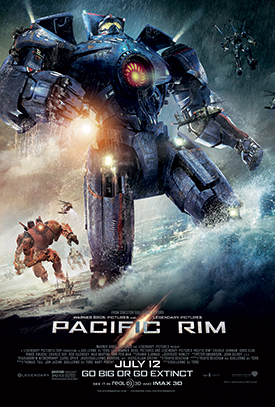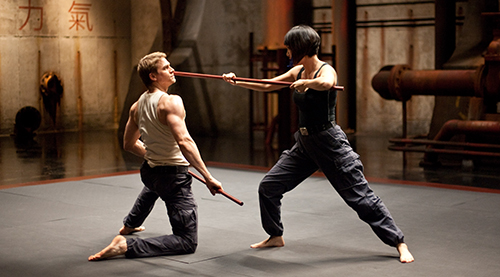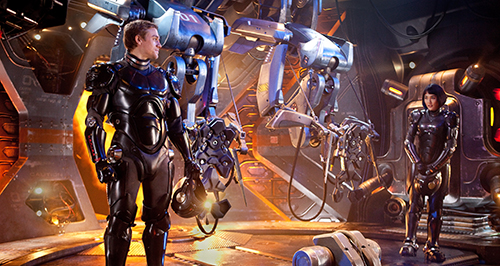 What's the cure for the summer blockbuster blues? Joss Whedon, mastermind behind Marvel's mammoth movie THE AVENGERS (2012), took 12 days off to shoot Shakespeare's MUCH ADO ABOUT NOTHING at his Santa Monica home with his favorite TV actors, in black and white no less. That's about as far of a directorial departure as possible. Guillermo Del Toro went the other direction. He made a monster mash-up movie by borrowing liberally from many of Hollywood's biggest-grossing franchises and stir-fried them all together for a gargantuan dish of cinematic chop-suey. PACIFIC RIM shamelessly poaches from so many blockbuster recipes that it almost borders on parody. And yet, it is a stand-alone film, not connected to any previously-established comic books, best-selling novels or line of toys, and there's something unique in that nowadays. If giant robots fighting giant monsters doesn't grab your attention, there's always Whedon's film. But if it does, PACIFIC RIM takes this time-honored B-movie genre to new depths in visionary IMAX 3D. What's more, it has martial arts too.
What's the cure for the summer blockbuster blues? Joss Whedon, mastermind behind Marvel's mammoth movie THE AVENGERS (2012), took 12 days off to shoot Shakespeare's MUCH ADO ABOUT NOTHING at his Santa Monica home with his favorite TV actors, in black and white no less. That's about as far of a directorial departure as possible. Guillermo Del Toro went the other direction. He made a monster mash-up movie by borrowing liberally from many of Hollywood's biggest-grossing franchises and stir-fried them all together for a gargantuan dish of cinematic chop-suey. PACIFIC RIM shamelessly poaches from so many blockbuster recipes that it almost borders on parody. And yet, it is a stand-alone film, not connected to any previously-established comic books, best-selling novels or line of toys, and there's something unique in that nowadays. If giant robots fighting giant monsters doesn't grab your attention, there's always Whedon's film. But if it does, PACIFIC RIM takes this time-honored B-movie genre to new depths in visionary IMAX 3D. What's more, it has martial arts too.
Within the first scene, PACIFIC RIM defines its players. The giant monsters are called Kaiju. That is the Japanese term used for monster movies - not human-sized monsters like vampires and zombies but monstrously huge monsters, like Godzilla. Kaiju could be literally translated as "dubious beast." The giant robots are called Jaegers, which is German for "hunter," the same word (albeit alternately spelled) that prefixes the hard liquor Jägermeister. There's one other major concept: because it takes two pilots to steer a Jaeger, they must engage in this Vulcan-like mind meld. This is called "drifting." That's all you really need to know. Got it? Let the destruction begin.

Del Toro's reputation for absurd monsters and his eye for the fantastic precedes him. His psychedelic work on the HELLBOY franchise (launched in 2004) and the disturbing PAN'S LABYRINTH (2006) established his quixotic style. Del Toro also worked on the screenplays for the new HOBBIT trilogy. Early in production there were rumors connecting him to an upcoming remake of GODZILLA, but Del Toro categorically denied any involvement. GODZILLA is being directed by Gareth Edwards and is slated for release in 2014, the sixtieth anniversary of the "King of Monsters." Hopefully it can redeem the god-awful 1998 GODZILLA remake that starred Matthew Broderick and bring honor back to that venerated Kaiju franchise that spans nearly 30 films. In one of the earliest scenes, prior to the opening title of PACIFIC RIM, one of the Kaiju's cries seems to echo Godzilla's iconic roar.
It's those minute homages, whether intentional or projected, that might keep fans of the genre chattering in PACIFIC RIM's wake. As in such films of fantasy, logic is often sacrificed for spectacle, and plot development only progresses to the next outrageous action scene. While PACIFIC RIM is an original story, much of it feels familiar. The primary Jaeger is named Gipsy Danger. In the center of Gipsy Danger's chest is a glowing disc, akin to the chest plate of IRON MAN. Like the fighting robot in REAL STEEL (2011), Gipsy Danger is also an "old school" robot, made obsolete by new technology, or perhaps not so. And of course, as this is a Hollywood film, Gipsy Danger is made in the U.S.A. The other major Jaegers are distinctly Russian (Cherno Alpha, piloted by a married couple) and Chinese (Crimson Typhoon, which has three arms and uses three pilots, Chinese triplets no less). As for the Kaiju, production notes claim that forty unique monsters were designed, but only nine made it to the silver screen. Prior to developing PACIFIC RIM, Del Toro was planning to undertake the unnamable, H.P. Lovecraft's horrific novel, At Mountains of Madness, and the biggest baddest Kaiju looks downright Lovecraftian. For the others, developed by some of the same designers that worked on THE HOBBIT and HELLBOY, anatomy is pinched from mythic creatures and inspired from classic art. Back stories exist for all of the Jaegers and Kaiju in additional materials, which will be good fodder for later merchandising should this film succeed.
But never mind the monsters and robots. What about those martial arts? Del Toro brought a huge team of stunt-people into the production, which might seem strange as so much of the action is computer generated special effects. And yet, the movements for the Jaegers must be motion-captured off something. And despite having a battery of missiles and energy blasters housed within their armor, the most effective means for a Jaeger to take down a Kaiju is traditional fisticuffs. SPOILER Even a Jaeger sword is used to better effect against Kaiju than guns and cannons END SPOILER. What's more, in an early scene, a Jostaff martial arts duel between pilots takes place in an arena bearing the Chinese characters for wu guan (martial hall) on the wall. In that duel, the main hero Raleigh Becket (Charlie Hunnam) faces off against a series of Asians: the Wei Tang triplets (real-life triplets Charles, Lance and Mark Luu) who pilot the Crimson Typhoon, and co-star co-pilot Mako Mori (Rinko Kikuchi). It's a tight little fight, not surprising considering the martial arts team behind it.

While most every stunt person needs to learn some martial arts as part of their trade, there is a unique class of stunt person that was brought up in the martial arts. They gravitate to stunt work as an expression of their art. Topping the PACIFIC RIM stunt team is Bradley Allen, a product of Beijing Wushu Team coaches. He is credited as being the first non-Chinese to make Jackie Chan's Stunt Team, but has since established himself as one of Hollywood's top choreographers. Allan still works with Jackie and had a hand in his most recent film, CHINESE ZODIAC 2012, but he has also delivered outstanding work of his own in Hollywood with such titles as NINJA ASSASSIN (2009), KICK-ASS (2010), and SCOTT PILGRIM VS. THE WORLD (2010). According to IMDB, joining Allan to coordinate PACIFIC RIM fights are Taekwondo practitioner Tommy Chang and Kali/Krav Maga exponent Branko Racki. Other noted martial artists include Parkour-ist Alex Armbruster, Taekwondo instructor Kimberly Chiang, Chinese-style sword-player Tyler Hall, Beijing Wushu Team graduate Li Jing, Karate Black Belt Simon Northwood, Canadian Heavyweight Boxing Champion Neven Pajkic, another Jackie Chan Stunt Team member Hyun Jin Park, Canadian Fight Director John Stead and several members of Canada's extreme martial arts group Team Ryouko: Allen Keng, Louis Paquette, Ilan Rosenberg, Alan Tang, and Emerson Wong. If that seems like a lot, well, there's a lot of action.

Opposite Shores of PACIFIC RIM
Nearly a year before PACIFIC RIM's premiere, Del Toro was outspokenly resistant to making this film in 3D. He felt that 3D wouldn't be able to show the magnitude of the monsters and robots, that somehow the process would diminish their scope. However, later in production, Warner Brothers overruled him. Not only does the 3D experience increase box office returns with higher-priced tickets, it parts the Bamboo Curtain to China's market. Now the second largest movie market in the world, China offers something that Hollywood wants - growth. Monstrous growth. China limits the number of Hollywood films to be distributed nationally each year. The approved films are mostly restricted to big blockbusters. Last year, the cap of twenty Hollywood films was raised to thirty-four; however, the additional fourteen came with the stipulation that they must be in 3D or IMAX formats.
Typically, post-production 3D comes off as rather flat, but not so with PACIFIC RIM. For live action, having a lot of atmospheric particles adds depth. Consider the dust motes in the beams of light in HUGO (2011) or all the glowing thingamabobs in AVATAR (2009). Many of the scenes in PACIFIC RIM are shot in the rain or snow or in areas filled with falling ash, all adding significant depth of field. Computers have holographic displays that also appear deeply layered; this is easier to achieve in post-production as it is special effect-based. Computer-generated images can be converted to 3D more effectively so the monsters and robots do appear huge, despite Del Toro's concerns. As 3D movies go, PACIFIC RIM is an excellent example of the medium at its best. In fact, it might not be as entertaining in 2D, so drop the extra bucks for the glasses. For such a bombastic, explosive action flick, you might as well indulge.

That other giant robot franchise, TRANSFORMERS, did staggeringly well in China, so much so that in the third installment there was Chinese product placement, the most glaring being a scene of Asian goofball Ken Jeong's slurping of Shuhua milk. He even calls it by name brand saying, "May I finish my Shuhua milk?" Not surprisingly, the next TRANSFORMERS is following the path of IRON MAN 3 (2013) by filming its fourth installment in China and adding Chinese super-starlet Li Bingbing to the cast. Given this success, PACIFIC RIM has potential in that market. If Del Toro and Warner Brothers is really looking to tap China, they need to expand the Chinese characters, just like IRON MAN 3 did. China got a different version of IRON MAN 3 that appealed more to Chinese audiences. The Chinese version accordioned with story development for additional Chinese characters, Dr. Wu (Chen Kaige) and Wu Jiaqi (Fan Bingbing, not to be confused with Li Bingbing). PACIFIC RIM's Wei Tang triplets are ripe for such expansion, but it's unknown if such forethought was put into production. What's more, a significant portion of the film takes place in Hong Kong. However, at this writing, a Chinese release is still pending.
Despite the gratuitous display of special effects, there is a certain nostalgia for the Japanese Kaiju films of old, before CGI, back when it was stuntmen in rubber costumes destroying model cities. The detail of those models was magnificent, and there's just nothing like the violence of a Kaiju smashing a world-renowned landmark. It's akin to those classic Samurai movies where actors were rigged with pipes of squirting blood. Today, Samurai films use a lot of CGI blood, which is easier because if a retake is needed, everyone's clothes need not be cleaned. However, when actors wince lest fake blood get sprayed in their eyes, it lends a strong sense of authenticity. In the same manner, while CGI explosions can be exciting, PACIFIC RIM, along with so many CGI-driven action films, lacks that sense of genuine destruction. Those old monster movies with guys in rubber suits had to be done in one take. If there was a mistake, the filmmakers couldn't just tap delete on their computers and move on.

What's more, the original Godzilla had a moral. Godzilla was a result of nuclear testing, an issue to which Japan is keenly sensitive. History shows again and again how nature points out the folly of men. In PACIFIC RIM, there is a fleeting moment where Dr. Newton Geiszler (played with great comic panache by ALWAYS SUNNY IN PHILADEPHIA's Charlie Day) makes a reference to climate change, but it is little more than a pause between explosions. There is some morality in the honor of the Jaeger pilots. Idris Elba delivers a noble performance, dominating every single scene he is in as the commander Stacker Pentecost, and Max Martini plays his typical battle-hardened soldier role as Herc Hansen. However, PACIFIC RIM doesn't reach beyond itself. It's a simple good versus evil tale, with little aspirations of anything beyond an entertaining way to spend two hours in a movie theater. If you want to escape the summer heat this year, there are worse ways than watching 3D monsters and robots fight for the fate of the world.
![]() Print Friendly Version of This Article
Print Friendly Version of This Article
















